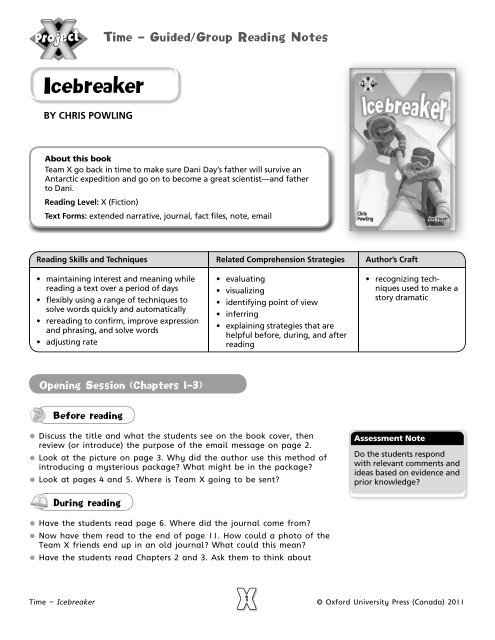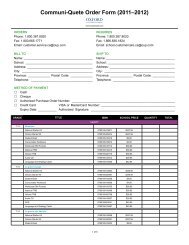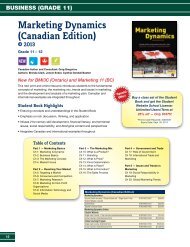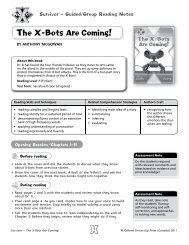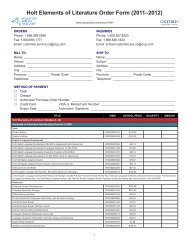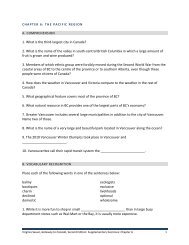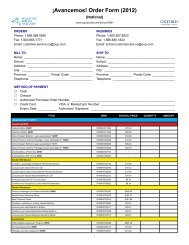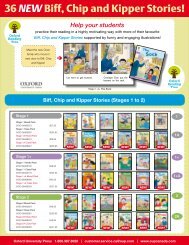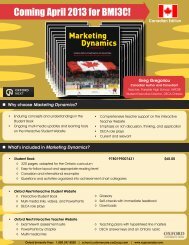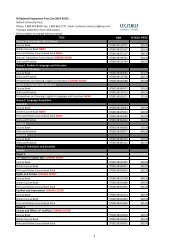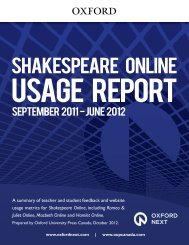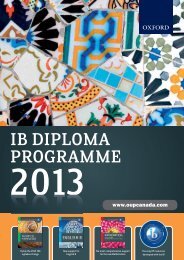Time Theme - Level X.pdf - Oxford University Press Canada
Time Theme - Level X.pdf - Oxford University Press Canada
Time Theme - Level X.pdf - Oxford University Press Canada
Create successful ePaper yourself
Turn your PDF publications into a flip-book with our unique Google optimized e-Paper software.
<strong>Time</strong> – Guided/Group Reading NotesJust in <strong>Time</strong>BY ANTHONY MCGOWANAbout this bookThe Collector is stealing famous timepieces from around the world. Team-Xare forced to go back in time to save the critically important Greenwich clock.Reading <strong>Level</strong>: X (Fiction)Text Forms: extended narrative, email, character profile, riddles, captions,fact files, map, notesReading Skills and Techniques Related Comprehension Strategies Author’s Craft• maintaining interest and meaning whilereading a text over a period of days• flexibly using a range of techniques tosolve words quickly and automatically• rereading to confirm, improve expressionand phrasing, and solve words• adjusting rate• evaluating• visualizing• identifying point of view• inferring• explaining strategies that are helpfulbefore, during, and after reading• recognizing varioustechniques usedby the author toprovide clues andinformationOpening Session (Chapters 1-2)Before reading• Display the front cover and read aloud the synopsis on the back cover.Ask the students to use this information to predict what the Collectoris up to in this book. (Review or introduce the Collector’s characterprofile using the information on page 3.)• Look at pages 4 and 5 together. Where will the story take place?• Review various ways to monitor comprehension. Remind the studentsthey must stop and take action if they do not understand the text.Assessment NoteDo the students respondwith relevant comments andideas based on evidence andprior knowledge?During reading• Have the students read Chapters 1 and 2. Ask them to use a stickynote to record any unusual or interesting words that help themvisualize the story.• Have individual students read a short section to you.Assessment NoteAs they read, take noteof the students’ fluency,self-monitoring and selfcorrection,and approachesto solving new words.4<strong>Time</strong> – Just in <strong>Time</strong> © <strong>Oxford</strong> <strong>University</strong> <strong>Press</strong> (<strong>Canada</strong>) 2011
<strong>Time</strong> – Guided/Group Reading NotesDuring reading• Ask the students to read Chapters 8 and 9, and to take particularnotice of the main characters’ emotions in these chapters.• Have individual students read a short section to you.After reading• Discuss with the students:What damaged the Master-bot?• (literal recall)• What emotions do Team X and the Collector experience throughoutthese chapters? Have the students complete the Collector’s“emotions” graph. (inferring, drawing conclusions)• Why does the author have the characters experiencing a range ofemotions throughout the story? What effect does this have on areader? (evaluating, adopting a critical stance, author’s craft)• What is the time-travel paradox in this story? Why could it be aproblem? (inferring, evaluating, drawing conclusions)• What are the main themes and ideas in this book? Which parts didyou especially like or dislike? (personal response, adopting a criticalstance, identifying main idea)Assessment NoteAs they read, take noteof the students’ fluency,self-monitoring and selfcorrection,and approachesto solving new words.Assessment NoteDo the students:• make inferences and drawconclusions based onevidence?• explain choices the authormade to enhance thestory?• offer reasoned personalopinions about the text?Additional activities• Word Study: Refer to the list of time-related words and phrases thatthe students found in the first two chapters. Examples (p. 9): deadline,hang on a second, the clock will be ticking. Ask them to work with apartner to find more time-related words and phrases in this book, orelsewhere, and add them to the group’s list. How easy is this task? Dothey hear a lot of time-related phrases in their everyday lives?(Common examples: recess time, indefinite, tomorrow, last year.)• Have the students:• write the Collector’s personal blog entries for the whole book,including information from their “emotions” graph.• imagine they saw the Peace Tower stolen from Ottawa. Have themwrite an email or Facebook post about what they saw.• research and create a fact file about one of the famous timepiecesfeatured in the story, including a drawing or 3-D model of thetimepiece.• make a sundial and test it on a sunny day.• create and share problems related to time zones. (e.g., LeaveLondon, England at 6 a.m. local time; fly for 8 hours; arrive inWinnipeg. What is the local time?)Assessment NoteDo the students:• identify frequently usedwords and phrases relatedto time?• reflect the Collector’spoint of view in their blogentries?• research and communicateimportantinformation in their factfile?<strong>Time</strong> – Just in <strong>Time</strong> 6© <strong>Oxford</strong> <strong>University</strong> <strong>Press</strong> (<strong>Canada</strong>) 2011
<strong>Time</strong> – Guided/Group Reading Notes<strong>Time</strong> CapsulesBY DEBORAH CHANCELLORAbout this bookThis book explores many types of time capsules and what they tell usabout various points in time.Reading <strong>Level</strong>: X (Non-Fiction)Text Forms and Features: non-chronological report, comparisons, emails,newspaper reports, explanations, debate, maps, chart, captions, factboxes, labels, photographs, labelled diagram, table of contents, glossary,index, quizReading Skills and Techniques Related Comprehension Strategies Author’s Craft• maintaining interest and meaning whilereading a text over a period of days• flexibly using a range of techniques tosolve words quickly and automatically• rereading to confirm, improve expressionand phrasing, and solve words• adjusting rate• evaluating• asking and answering questions• explaining strategies that are helpfulbefore, during, and after reading• determining important information• evaluating the credibility of the textsource• recognizing howauthors use morethan one text formto present informationaccording topurposeOpening Session (pages 2-13)Before reading• Look at the book cover and contents page with the students anddiscuss what they know about time capsules.• Read page 2 together and discuss the students’ responses to thequestion in paragraph two. List their ideas.• Tell the students that they will be creating a computer-based timecapsule about life at school. As they read this book, they should thinkabout what could be included in the electronic files.• Conduct a brief review of ways to solve new words, including use ofthe glossary and labels. Remind the students to monitor theircomprehension and take action if they do not understand the text.Assessment NoteDo the students respondwith relevant comments andideas based on evidence andprior knowledge?7<strong>Time</strong> – <strong>Time</strong> Capsules © <strong>Oxford</strong> <strong>University</strong> <strong>Press</strong> (<strong>Canada</strong>) 2011
<strong>Time</strong> – Guided/Group Reading NotesDuring reading• Have the students skim pages 4 to 13, using headings, subheadings,and graphics to select two sections that most interest them. Ask themto read the two sections thoroughly and think about how artifactsbecome “locked away.” Is it intentional or unintentional?• Listen to individual students read short sections.Assessment NoteAs they read, take noteof the students’ fluency,self-monitoring and selfcorrection,and approachesto solving new words.After reading• Ask the students to list the ways in which the artifacts described inthis part of the book have become time capsules. (literal recall)• Have the students orally summarize their chosen part of the text. Askothers in the group to create questions about the summaries, drawingon various quadrants of a Q-Chart/Q-Matrix. (asking and answeringquestions, summarizing)• Look through pages 4 to 13 and talk about the different ways theauthor has presented the information. Why has the author useddifferent structures and forms? How do they relate to the audienceand purpose? (author’s craft)• Ask students to describe the comprehension strategies they noticedthemselves using while reading. How did the text features help themAssessment NoteDo the students:• recall factual information?• generate open and closedquestions?• understand why theauthor used various textfeatures and forms?• articulate their comprehensionstrategies?understand? (metacognition)Independent Reading (pages 14-23)Ask the students to read pages 14 to 23. Once finished, they are to go•back to reread the section that most interested them.Consolidation Session (pages 24-29)Before reading• Talk about the sections between pages 14 and 23 that students foundmost interesting. Ask them to work with a partner to create questionsabout the section they particularly liked. Remind them to use varioustypes of questions.• Look at the list of time capsule contents on page 21. Ask students howthis differs from what they would include in a time capsule torepresent their school. What is the same? Why?Assessment NoteDo the students:• explain why they liked aspecific section?• ask and answer a range ofquestions about the text?<strong>Time</strong> – <strong>Time</strong> Capsules 8© <strong>Oxford</strong> <strong>University</strong> <strong>Press</strong> (<strong>Canada</strong>) 2011


